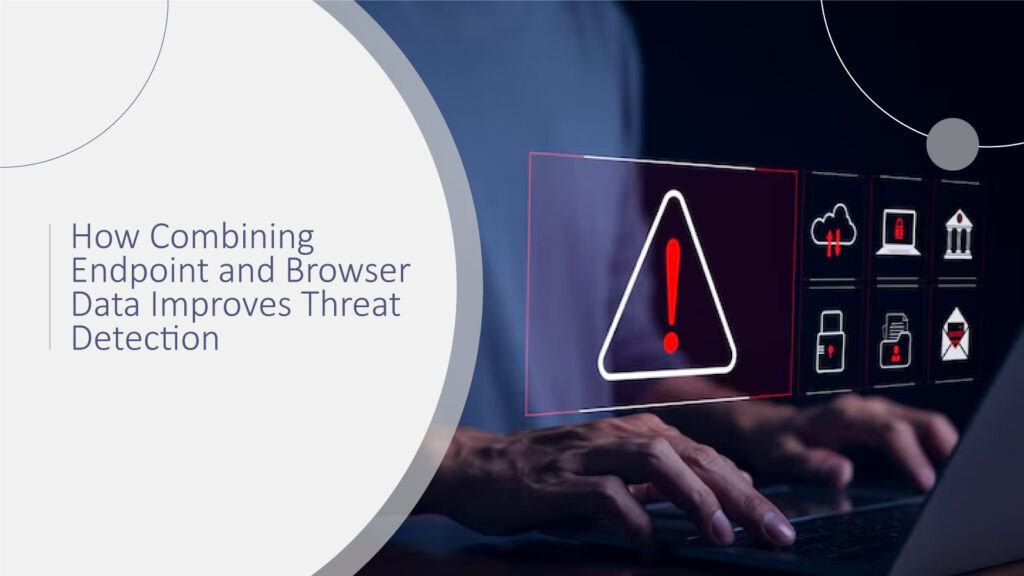Threat detection starts where visibility does, and that is where endpoints and browsers intersect. It is no longer about responding after the breach, it is about predicting the threat before it spreads. When you combine real-time browser activity with endpoint telemetry, you don’t just make your defense stronger, you redefine it. This is not the future of cybersecurity; it is what today’s enterprises need to do to stay ahead.
Why This is Important in 2025
Cybersecurity teams are drowning in fragmented telemetry. While endpoint detection and response (EDR) solutions deliver deep insights into device-level threats, they often miss what happens inside the browser, one of the most common entry points for phishing, credential theft, and session hijacking. On the other hand, browser security tools capture real-time user behavior and web activity but lack endpoint context. Combining both creates a high-fidelity picture of threats and closes detection gaps.
According to IBM’s 2024 X-Force Threat Intelligence Index, over 36% of successful breaches began in the browser via malicious extensions, drive-by downloads, or phishing links. Yet, many organizations still treat browser activity as an afterthought in their SIEM and XDR strategies.
1 Increased Visibility Throughout the Attack Chain
Endpoint information informs you of what is occurring on the device, what applications are being executed, what processes are launched, and how files are altered. But browser information informs you why those processes were initiated: What was the clicked link? What was the visited page? Was it an MFA request or a phony login page?
Combined, these viewpoints provide the complete attack chain. For example, when an employee clicks on a phishing email link, browser telemetry tracks that click. If someone subsequently downloads malware, the endpoint data logs file activity. By correlating both, analysts can identify the threat in real-time, rather than relying on alerts from separate systems or incident post-forensics.
2 Real-Time Threat Detection Through Correlation
By combining browser and endpoint telemetry in real-time, organizations can initiate quicker, smarter threat detections. Think of this example: A browser session accesses a malicious domain, and soon afterward, PowerShell is opened with obfuscated commands. Individually, these may appear unrelated or be overlooked. Together, they are a red flag for a fileless malware attack.
This type of correlation is what gives solutions such as CrowdStrike Falcon and Microsoft Edge for Business integration so much power. The Falcon platform consumes browser activity as an input data source, correlates it with endpoint activity, and facilitates real-time analytics to identify multi-step attacks that cross user interaction and system response.
3 Credential Abuse Prevention
Attackers have adopted credential theft as one of the most common attack vectors in recent times. According to the 2024 DBIR, a human factor caused 74% of breaches, and attackers based 49% on credentials.
When security teams consider browser behavior (for example, frequent attempts at login or navigation to well-known phishing sites) in combination with endpoint behavior (like unauthorized session token export), they can rapidly identify and stop credential stuffing or session hijacking attempts with Threat Detection. Today’s SIEMs, such as Falcon, automatically send alerts when they connect browser anomalies to dangerous endpoint activity, allowing the user to respond quickly with the context they need. This reduces dwell time and constrains the attacker’s window of opportunity.
4 Improving Zero Trust Enforcement
Zero Trust relies on the principle of “never trust, always verify,” particularly at the user and application level. Browser information bolsters that model by confirming what users access and how. If a user signs into a cloud resource from a managed device (endpoint telemetry verifies it), but the browser indicates that the session redirected to an unsanctioned domain, the system blocks access in real time.
This dual-mode capability enables policies to dynamically adjust. For instance, if an endpoint is identified as high risk (in terms of patch outdatedness or malware presence), browser access can be dynamically blocked, precluding lateral movement or exfiltration by web-based avenues.
5 Streamlining Security Operations
When one dashboard, like the Falcon console, brings together endpoint and browser information, analysts do not have to switch between several tools. This saves them from alert fatigue, speeds up incident triage, and enables teams to respond with accuracy.
A 2023 ESG report determined that companies with combined telemetry decreased mean time to detect (MTTD) by 43% and enhanced investigation speed by more than 50%. This type of efficiency might be the difference between early threat containment and an expensive breach.
How is It Beneficial to Security Leaders
Threat detection is now an end-of-business problem and no longer strictly an IT problem. CISOs, CIOs, and SOC managers face challenges in delivering rapid, accurate results without inflating headcount or going over security budgets. That’s why feeding browser and endpoint information into one telemetry stream isn’t just smart, it’s necessary. Here’s why it directly benefits the leaders shaping enterprise security strategy:
Make better decisions with complete context
Threat detection greatly improves when decision-makers can see the entire kill chain, starting from the first click of a suspicious link in the browser all the way through to endpoint activity afterwards. Instead of analyzing isolated signals in a silo, leaders have deep situational context. It’s multi-layer visibility that enables faster triage, smarter response actions, and improved incident correlation. No longer is it about reacting; it’s about predicting.
Increase ROI on existing tools with intelligent correlations
Security teams spend money on SIEM, EDR, SOAR, and threat intelligence platforms, but don’t receive maximum value from them because data is isolated. By bringing browser and endpoint data together, these products get more accurate and less noisy. For example, a browser logon failure that is seen in conjunction with an endpoint process anomaly will initiate a high-fidelity alert, minimizing false positives and hours of analyst time. This correlated strategy multiplies the return on each dollar spent on cybersecurity infrastructure.
Scale Zero Trust policies at scale, without human intervention
Zero Trust is not an architecture, it’s a living design. Yet, the majority of teams can’t maintain policies in sync across all environments. By converging browser behavior and endpoint posture, organizations can make conditional access decisions automatically. When the browser exhibits suspicious access behavior, and the endpoint is marked as high-risk, dynamic policy enforcement can step in to block access, isolating the session, or requesting MFA. This frictionless feedback loop enforces Zero Trust at scale, without constant manual tuning.
Enhance user security with zero effect on productivity
The threat detection must be proactive and non-intrusive. By pulling in browser telemetry like download attempts, domain reputation, and session activity, along with endpoint telemetry, organizations are able to detect malicious behavior early on without any impact on the user experience. For instance, if a phishing site is accessed, the browser layer alerts this in real-time, and the endpoint responds by encapsulating potential payloads, without any interruption to the user or requirement for intervention. This combination of security and speed is vital to modern workplaces online.
Provide more transparent metrics to the board
Security leaders are no longer just technical custodians, they’re risk managers. By correlating and aggregating endpoint and browser telemetry, they are able to offer quantifiable, board-worthy insights that map directly to business objectives. Compliance initiatives like NIST, ISO 27001, and SOC 2 can link mean time to resolve, dwell time reduction, and percentage contained early threats. Transparency fuels leadership buy-in, invites budget discussions, and turns cybersecurity into a mission-critical business enabler, rather than an expense.
Merging endpoint and browser data isn’t a nice-to-have; it’s a must for timely, precise, and actionable threat detection. From improved response times to richer context, this combination approach allows security teams to get ahead of tomorrow’s threats without sacrificing user experience or productivity. As threats evolve, so must defenses. Merging browser and endpoint telemetry is one of the most intelligent decisions a cyber leader can make in 2025.
FAQs
1. How difficult is it to integrate browser telemetry with existing endpoint solutions like CrowdStrike Falcon or Microsoft Defender?
Integration is relatively straightforward with modern platforms. Tools like CrowdStrike Falcon already support native integration with Microsoft Edge for Business, allowing browser data to be collected without custom development. Many SIEM and EDR solutions offer built-in connectors or APIs that simplify the process. With the right setup, security teams can combine browser and endpoint telemetry within hours, not weeks.
2. Won’t collecting more telemetry slow down performance or create compliance risks with user privacy?
Not if done correctly. Developers design modern telemetry tools to run in the background with low resource consumption, so they rarely cause performance issues. In terms of privacy, leading solutions offer granular controls that restrict data collection and access to it. They also support compliance frameworks like GDPR and CCPA by anonymizing sensitive data and enforcing role-based access to ensure users’ privacy is respected.
3. What types of attacks are best identified using a combination of browser and endpoint telemetry?
This approach is most effective against multi-stage attacks that start with user interaction and move into system compromise. Common examples include phishing that leads to malware downloads, credential theft, followed by unauthorized access, or fileless malware that starts in the browser and spreads through the device. Combining both data sources reveals the full attack chain, allowing earlier and more accurate threat detection.
4. How does this strategy fit into Zero Trust security models already in place?
It enhances Zero Trust by providing more context for access decisions. With both browser and endpoint data, organizations can automatically adjust access controls in real time. For instance, if a device is trusted but the browser detects suspicious behavior, the system can block or challenge access to sensitive resources. This makes Zero Trust more dynamic and responsive without needing constant manual updates.
5. What kind of ROI or operational benefit can security leaders expect from this integration?
Security leaders can expect faster detection, fewer false positives, and more efficient SOC operations. Studies have shown that combining browser and endpoint data reduces time to detect by over 40% and speeds up investigation by 50%. It also helps teams do more without adding staff and improves reporting for the board by providing clearer metrics. Overall, it turns existing tools into smarter investments and strengthens enterprise security posture.
To participate in upcoming interviews, please reach out to our CyberTech Media Room at sudipto@intentamplify.com.







